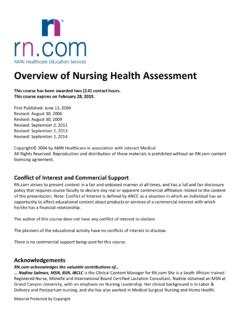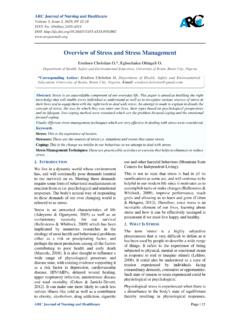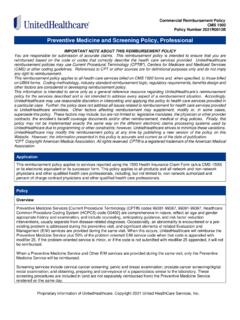Transcription of Nutrition Focused Physical Exam (NFPE)
1 Nutrition Focused Physical Exam (NFPE)Ashley Strickland, RDN, LDN, CNSCI ndiana Academy of Nutrition and Dietetics Annual ConferenceApril 13, 2017 Course Objectives Discuss the importance of developing a competency process to deem clinicians competent to practice an NFPE. Review the Clinical Criteria used to identify malnutrition Understand how to assess muscle and fat sites for signs of wasting 2 Course OverviewPre-Reading Each participant will read 4 Articles:Initial Competency Review curriculum utilizing power point presentation Break Out Sessions (Fat, Muscle and Edema Assessment) Using the 3 case studies, complete a Physical assessment simulation in order to determine if malnutrition diagnosis is appropriate Perform Head to Toe Exam based on guidelines, and meet competency 1-3 Months & Annual competency Each Dietitian will complete 2 Physical Assessments identifying patients with Malnutrition. Validation will be completed by Subject Matter Experts3 Subject Matter Expert The following has been completed by the subject matter expert: Independent contractor for The Academy of Nutrition and Dietetics as a trainer to provide malnutrition workshops to dietitians across the nation.
2 Attended a 2 day seminar, title The Nutrition Focused Physical examination at Rutgers School of Health Related Professions. Competencies acquired were validated by a medical professional, upon completion of this seminar. Attended a 1 day seminar, titled Diagnosing Malnutrition: Understanding the Role of Muscle and Fat Loss at Novant Health Presbyterian Medical Center. Competencies acquired were validated by a medical professional, upon completion of this seminar. Completed an online education program, titled Patient Simulation: Putting Malnutrition Screening, Assessment, Diagnosis, and Intervention into Practice . 1 hour of continuing education was obtained, upon completion of this program. Completed multiple peer reviewed Nutrition Focused Physical exams4 Order Entry Malnutrition Documentation (Dietitian Note)6 Scope of Practice in Nutrition Care for RDNs The RDN can conduct a Nutrition Focused Physical examination Nutrition - Focused Physical findings assessment (often referred to as clinical assessment): Assessed findings from evaluation of body systems, muscle and subcutaneous fat wasting, oral health, hair, skin and nails, signs of edema, suck/swallow/breath ability, appetite and affect.
3 Differentiate normal vs non-normal findings Assess and intervene in findings that are relevant to the patient s care Refer and collaborate with the medical/Interdisciplinary teamJAND 2013 113 (6 Suppl): S56-71 Malnutrition Prevalence 1/3 hospitalized patients are malnourished upon admission A major contributor to increased morbidity and mortality, decreased quality of life, increased length of stay, and readmissions Nutrition interventions are low risk and cost effectiveTappenden et al. JPEN 2013 Goal for Inter-professional Approach to Address Malnutrition Create a culture where Nutrition is valued Include multiple disciplines in Nutrition care Identify and diagnose all patients with malnutrition or those that are at risk for becoming malnourished Implement comprehensive Nutrition interventions Develop discharge Nutrition care and education plansTappenden et al. JPEN 2013 Etiology-Based Malnutrition DefinitionsNutritional Risk Identified Compromised intake or loss of body massInflammation present?
4 No/YesNoStarvation Related Malnutrition(pure chronic starvation, anorexia nervosa)YesMild-ModeratedegreeYesMarked Inflammatory responseChronic Disease-Related Malnutrition(organ failure, pancreatic cancer, rheumatoid arthritis, sarcopenic obesity)Acute Disease or Injury-Related Malnutrition(major infection, burns, trauma, closed head injuryJensen 2009;33:710 Malnutrition Etiologies Acute Illness/Injury Severe inflammation Chronic Illness Mild to moderate inflammation Occurring for 3 months or longer Social/ Environmental Circumstances Chronic starvation, NO inflammationAcute Illness/Injury with Severe Inflammation Inflammation is acute and of severe degree Examples: Major infection/sepsis ARDS, burns, trauma Closed head injury Major surgery (any surgery that involves a major organ)Jensen GL. Malnutrition and inflammation burning down the house. JPEN, Illness with Mild-Moderate Inflammation Inflammation is chronic and of mild-moderate degree Examples: Organ failure (kidney, liver, heart, lung, gut Cancer Rheumatoid arthritis CHD Cystic fibrosis Celiac disease IBD CVA Chronic pancreatitis DMJensen GL.))
5 Malnutrition and inflammation burning down the house. JPEN, or Environmental CircumstancesNO inflammation Chronic starvation without inflammation Examples: Depression (currently a questionable dx for this category) Economic hardship Cognitive or emotional impairment Inability or lack of desire to manage self-care Physical conditions: ingestion of foreign bodies Anorexia nervosa Poor oral/dental conditionsJensen GL. Malnutrition and inflammation burning down the house. JPEN, Malnutrition : Must have at least 2 categoriesICD-10:E44 Severe,Protein-Calorie MalnutritionSevere Malnutrition in thecontext of Acute Illness/InjurySevere Malnutrition in the contextof Chronic IllnessSevere Malnutritionin the context of Social/Behavioral/Environmental CircumstancesWeightLossWeightLoss>2% in 1 week>5% in 1 month> in 3 monthsWeight Loss>5% in 1 month> in 3 months>10% in 6 months>20% in 12 monthsWeightLoss>5% in 1 month> in 3 months>10% in 6 months>20% in 12 monthsIntakeEnergy Intake 50%energy intake compared to estimated energy needs for 5 daysEnergy Intake 75% energy intake comparedto estimated energy needs for 1 monthEnergy Intake 50% energy intake compared to estimated energy needs for 1 monthBodyFatBodyFatModerate depletion BodyFatSevere depletionBodyFatSevere depletionMuscleMassMuscleMassModerate depletionMuscle MassSevere depletionMuscleMassSevere depletionFluid AccumulationFluid AccumulationModerateto SevereFluid AccumulationSevereFluid AccumulationSevereGrip StrengthReduced
6 Grip Strength for age and gender or RegressedFunctional StatusReduced Grip Strength for age and gender or RegressedFunctional StatusReduced Grip Strength for age and gender or RegressedFunctional StatusModerate Malnutrition -Must have at least 2 categoriesICD-10:E43 Malnutritionof Moderate DegreeModerate Malnutritionin the context of Acute Illness/InjuryModerate Malnutrition in the contextof Chronic IllnessModerate Malnutritionin the context of Social/Environmental CircumstancesWeightLossWeightLoss1-2% in 1 week5% in 1 in 3 monthsWeight Loss5% in 1 in 3 months10% in 6 months20% in 12 monthsWeight Loss5% in 1 3 months10% in 6 months20% in 12 monthsIntakeEnergy Intake<75%energy intake compared to estimated energy needs for >7daysEnergyIntake<75% energy intake compared to estimated energy needs for 1 monthEnergyIntake<75% energy intake compared to estimated energy needs for 3 monthsBody FatBodyFatMild depletionBody FatMild depletionBody FatMilddepletionMuscle FatMuscle MassMild depletionMuscle MassMild depletionMuscle MassMild depletionFluidAccumulationFluid AccumulationMildFluidAccumulationMildFlu id AccumulationMildGrip StrengthReduced Grip StrengthNotapplicableReduced Grip
7 StrengthNotapplicableReduced Grip StrengthNotapplicable Albumin/Prealbumin Albumin/prealbumin: Not good indicators of nutritional status! [Albumin and prealbumin], although probable indicators of inflammation, do not specifically indicate malnutrition and do not typically respond to feeding interventions in the setting of active inflammatory response. Thus, the relevance of laboratory tests of acute phase protein levels, as indicators of malnutrition, is limited . Serum proteins such as serum albumin and prealbumin are not included as defining characteristics of malnutrition because recent evidence analysis shows that serum levels of these proteins do not change in response to changes in nutrient intake .17 Severity of Malnutrition Mild Malnutrition Evidence is lacking to be able to distinguish between mild and moderate malnutrition in the clinical setting, therefore there is no standard definition of mild malnutrition18Be familiar with you patient s anatomy!
8 Prior to performing an NFPE on your patient, it is important to be familiar with their general anatomy, line placements, ostomies, Does the patient have a PICC? Male versus female Age Are there any ostomies or lines that would inhibit you from taking their gown or blankets off? Is the patient stable to reposition? Is there any prior injury, surgery, or non- Nutrition related issue, that would cause your patient to have an abnormal presentation of an area on their body ( amputations, arthritis, previous surgery, cupital tunnel and carpal tunnel syndrome, paralysis, )19 BODY FAT20 Assessment: Body Fat Loss Orbital RegionExam areaTipsSevereMalnutritionMild moderatemalnutritionWell -nourishedOrbital region surroundingthe eyeView patient whenstanding directly infront of them,touch abovecheekboneHollow look,depressions,dark circles,loose skinSlightly darkcircles,somewhat hollowlookSlightlybulged fatpads. Fluidretentionmay masklossNutrition in Clinical Practice 28 (6): 639-650 Facial MusclesOrbital Region (Orbital fat pads)NormalMild-ModerateSevere23 Assessment: Body Fat Loss Upper Arm AreaExam areaTipsSeveremalnutritionMild moderatemalnutritionWell-nourishedUpper armregion triceps/bicepArm bent, roll skinbetween fingers,do not includemuscle in pinchVery little spacebetween folds,fingers touchSome depthpinch, but notampleAmple fattissueobviousbetweenfolds of skinNutrition in Clinical Practice 28 (6): 639-650 Triceps/Bicep MusclesTricepsNormalMild-ModerateSevere2 6 Assessment: Body Fat Loss (Thoracic and Lumbar Region)Exam areaTipsSeveremalnutritionMild moderatemalnutritionWell-nourishedThorac ic andlumbar region ribs, lowerback,midaxillarylineHave patientpress hands hardagainst a solidobjectDepressionbetween theribs veryapparent.
9 Iliaccrest prominentRibs apparent,depressionsbetween themless crestsomewhatprominentChest is full,ribs do notshow. Slightto noprotrusion ofthe iliac crestNutrition in Clinical Practice 28 (6): 639-650 Thoracic/Lumbar Region and Midaxillary LineThoracic/Lumbar Region and Midaxillary LineNormal Mild-ModerateSevere29 MUSCLE30 Assessment: Muscle Loss Temple RegionExam areaTipsSeveremalnutritionMild moderatemalnutritionWell-nourishedTemple region/Temporalis muscleView patient whenstanding directly infront of them, askthem to turn headside to sideHollowing, scooping,depressionSlight depressionCan see/feelwell-definedmuscleNutrition in Clinical Practice 28 (6): 639-650 Temple region/ Temporalis muscleTemporal RegionNormalMild-ModerateSevere33 Assessment: Muscle Loss (Clavicle Bone Region)Exam areaTipsSeveremalnutritionMild moderatemalnutritionWell-nourishedClavic le boneregion Pectoralismajor, deltoid,trapezius musclesLook for prominentbone. Make surepatient is nothunched forwardProtruding, prominentboneVisible in male, someprotrusion in femaleNot visible inmale, visiblebut notprominent infemaleNutrition in Clinical Practice 28 (6): 639-650 Clavicle bone region, Pectoralis Major, Deltoid, Trapezious MusclesTrapeziusClaviclePectoralisClavic le RegionNORMALMILD-MODERATESEVEREA ssessment: Muscle Loss(Acromion Bone Region-Deltoid Muscle)Exam AreaTipsSevere MalnutritionMild-Moderate MalnutritionWell NourishedClavicle &Acromion boneregion DeltoidmusclePatient arms atside; observeshapeShoulder to armjoint shape lookssquare.
10 Acromionprotrusion veryprominentAcromion processmay slightlyprotrudeRounded,curves atarm,shoulder,neckNutrition in Clinical Practice 28 (6): 639-650 Acromion Bone region-Deltoid MuscleAcromion Bone Region-Deltoid MuscleNORMALMILD-MODERATESEVEREA ssessment: Muscle LossScapular Bone region, Trapezious, Supraspinatus, Infraspinatus musclesExamAreaTipsSevere MalnutritionMild-Moderate MalnutritionWell NourishedScapular boneregion Trapezius,supraspinatusinfraspinatusmusc lesAsk patient toextend handsstraight out,push againstsolid objectProminent, visiblebones,depressionsbetween ribs/scapula orshoulder/spineMild depressionor bone mayshow slightlyBones notprominent,nosignificantdepressionsNut rition in Clinical Practice 28 (6): 639-650 Scapular Bone region, Trapezious, Supraspinatus, Infraspinatus MusclesScapular Bone region, Trapezious, Supraspinatus, Infraspinatus MusclesNormalMild-ModerateSevere42 Assessment: Muscle Loss Dorsal Hand-Interosseous MuscleExam AreaTipsSevereMalnutritionMild-ModerateM alnutritionWell NourishedDorsal hand InterosseousmuscleLook at thumbside of hand.



